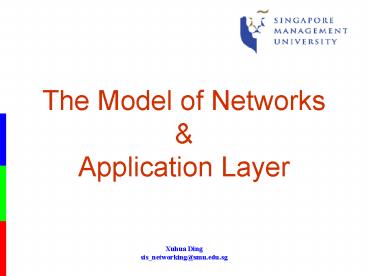Xuhua Ding - PowerPoint PPT Presentation
1 / 26
Title: Xuhua Ding
1
The Model of NetworksApplication Layer
2
Key Points
- The layer model of networks
- The functions of Physical Layer, Data Link Layer,
Network Layer, Transport Layer - Multilayer Communications
- The concept of protocols
- Some important features of Web transactions.
3
Alice Bob Post System
hi Bob,
4
Autopsy of Functionality
- Alice and Bob may send to each other letters,
postcards, parcels, flowers - They may use Singapore Post, FedEx, EMS, UPS
- (Suppose Alice and Bob choose Singapore Post)
Postmen choose the delivery route - local road, freeway, aviation,
- Drive on the streets
What to deliver to Whom?
How to arrange the delivery? (logically)
How to deliver? (physically)
5
Implicit Requirements
- Alice must know Bobs address
- Bob should understand Alices language
- The service should be available in both Alice and
Bobs cities. - There should exist a path between Alice and Bobs
cities.
6
Data Communication
www.yahoo.com
Web Surfing
Internet
7
Functions
Data Communication
What to deliver to Whom?
How to arrange the delivery? (logically)
How to deliver? (physically)
8
Internet Model
5. Application Layer
4. Transport Layer
3. Network Layer
2. Data-link Layer
1. Physical Layer
9
ISO/OSI Seven Layers Model
Application- provides access to the OSI
environment for users and also provides
distributed information services
Presentation- provides independence to the
application process from difference in
data representation
Session- provides the control structure for
communication between applications
establishes manages, and terminates connections
(sessions) between two applications
Transport- provides reliable, transparent
transfer of data between end points provides
end-to-end error recovery and flow control
Network- provides upper layers with independence
from the data transmission and switching techs
used to connect systems responsible for
establishing, maintaining connections
Data Link- for reliable transfer of information
across the physical layer sends blocks with
synchronization, error control and flow control
Physical- transmission of unstructured bit stream
over physical medium deal with the mechanical,
electrical, functional and procedural
characteristics
10
Multilayer Communications
11
Peer Process Abstraction
12
Message Flow Through Layers Encapsulation
5. Application Layer
User Data
Data
Data
4. Transport Layer
TCP
Data
3. Network Layer
2. Data Link Layer
1. Physical Layer
13
Importance of standardization
- The need for standards
- Vendors feel encouraged to implement the
standards - Customers are in a position to require that the
standards be implemented. - Two main types of standards
- De facto (from the fact)
- De jure (by law)
- The Standards-Making Process
- standard-making bodies ISO, ITU-T, ANSI, IEEE,
IETF
14
Concept of a Protocol
15
TCP/IP Protocol Stack
5. Application Layer
HTTP
FTP
SMTP
TELNET
SNMP
4. Transport Layer
TCP
UDP
RSVP
ICMP
OSPF
3. Network Layer
IP
2. Data Link Layer
HDLC
LAPB
LAPD
LLC
1. Physical Layer
Portions of ISDN, LAN, DSL, RS-232, V.92 Modem
16
Three Concepts
- Service what the layer does
- Interface how to access the layer
- Protocol how does the layer work
Service
Layer 2
Interface
Protocol
Layer 1
17
Web of Web
- Born in 1989 by European Particle Physics
Laboratory. - 1991 First Web browser
- 1993 about 200 web servers
- 1994 Netscape was formed
- 1995 Apache 0.6.2
- 2004 more than 100 Million web servers !
- Two central WWW ideas are hyperlinks and Uniform
Resource Locators (URLs).
18
How the Web Works HTTP
- Web Protocol HTTP (Hypertext Transfer Protocol)
- Web Browser and Web Server
- HTTP request
- URL (Uniform Resource Locator)
- GET
- HTTP response
- HTML (Hypertext Markup Language)
19
Example of an HTTP Request from a Web browser
Command URL HTTP version
GET http//www.kelley.indiana.edu/ardennis/home.ht
m HTTP/1.1 Date Mon 06 Aug 2001 173546
GMT User-Agent Mozilla/6.0 Referer
http//www.indiana.edu/aisdept/faculty.htm
- Request Line
- Date
- Web browser (this is Netscape)
Request Header
URL that contained the link to the requested URL
20
The built-in HTTP request methods
21
Statelessness
- The statelessness model was perfect. Now the
problems come. - Cookie a file or string provided by Server and
stored in users hard disk - Misuses of cookies
22
Static Web pages
- HTML not provide structure to pages
- Structured Web pages
- XML describe Web content in a structured way
- XSL describe the formatting independent of the
content - Motivation for automated processing (what is the
impact??)
23
Dynamic Web Pages
- Server-side dynamic web page generation accept
incoming information from forms, look up
information in databases and generate HTML pages
with the results - CGI
- PHP (Hypertext Preprocessor) script (open source)
- JSP (JavaServer Pages) (SUN)
- ASP (Active Server Pages) (Microsoft)
24
Dynamic Web Pages
- Client-side Dynamic Web page generation respond
to mouse or interact with users directly - JavaScript
- JavaApplet with JVM
- Microsoft ActiveX Controls
25
Web page generation and display
26
Summary
- The layered approach to network communications
- TCP/IP model five layers
- physical layer
- data link layer
- network layer
- transport layer
- application layer
- Multilayer communication
- Web
- basic http operations
- stateless web and cookie
- dynamic web page generation
27
Connection-Oriented and Connectionless Services
- Connection-oriented service like a pipe
- Connectionless service































